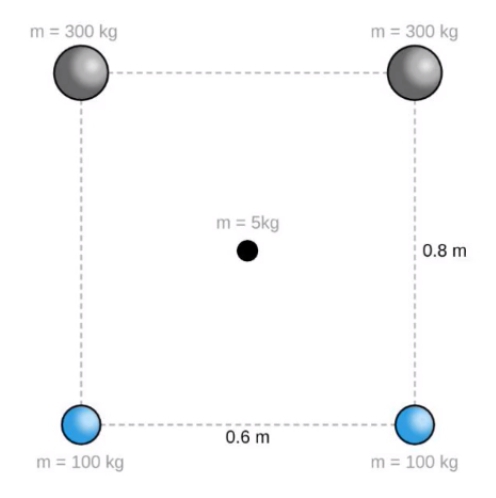The universal law of gravitation can be extended from one-dimensional scenarios to two-dimensional arrangements, where multiple forces act on an object simultaneously. In such cases, the net gravitational force is determined through vector addition rather than simple arithmetic. For instance, if two forces are acting on an object, one with a magnitude of 3 newtons and another with a magnitude of -4 newtons, the net force can be calculated by considering their directions, resulting in a net force of -1 newton directed accordingly.
When analyzing a system of masses arranged in a triangular formation, each mass exerts gravitational forces on the others. To find the net gravitational force acting on a specific mass, it is essential to decompose the forces into their x and y components using trigonometric functions, specifically sine and cosine. This decomposition allows for the calculation of the net force by summing the components in each direction.
For example, consider a mass \( m_1 \) influenced by two other masses \( m_2 \) and \( m_3 \). The forces between these masses can be labeled as \( F_{12} \) and \( F_{13} \). To find the net gravitational force, one must add these vectors using the tip-to-tail method. The magnitude of the resultant force can be calculated using the Pythagorean theorem, where the net force \( F_{net} \) is given by:
\[ F_{net} = \sqrt{F_{12}^2 + F_{13}^2} \]
To compute the individual forces, Newton's law of gravitation is applied:
\[ F = \frac{G \cdot m_1 \cdot m_2}{r^2} \]
where \( G \) is the gravitational constant, \( m_1 \) and \( m_2 \) are the masses, and \( r \) is the distance between them. For instance, if \( m_1 \) and \( m_3 \) are 25 kg and 20 kg respectively, and the distance between them is 0.1 m, the force \( F_{13} \) can be calculated as:
\[ F_{13} = \frac{6.67 \times 10^{-11} \cdot 25 \cdot 20}{(0.1)^2} = 3.34 \times 10^{-6} \text{ N} \]
Similarly, for \( F_{12} \) with a distance of 0.15 m and masses of 25 kg and 30 kg, the calculation yields:
\[ F_{12} = \frac{6.67 \times 10^{-11} \cdot 25 \cdot 30}{(0.15)^2} = 2.23 \times 10^{-6} \text{ N} \]
With both forces calculated, the net gravitational force can be determined as:
\[ F_{net} = \sqrt{(3.34 \times 10^{-6})^2 + (2.23 \times 10^{-6})^2} = 4.02 \times 10^{-6} \text{ N} \]
To find the direction of the net force, the angle \( \theta \) can be calculated using the tangent function:
\[ \tan(\theta) = \frac{F_{12}}{F_{13}} \]
Thus, the angle is given by:
\[ \theta = \tan^{-1}\left(\frac{2.23 \times 10^{-6}}{3.34 \times 10^{-6}}\right) \approx 33.7^\circ \]
This comprehensive approach illustrates how to analyze gravitational forces in two dimensions, emphasizing the importance of vector addition and trigonometric functions in determining both the magnitude and direction of the net gravitational force.



